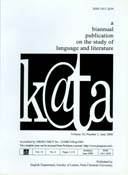God Humanization in Oka Rusmini's "Putu Menolong Tuhan"
Abstract
Oka Rusmini's short-story "Putu Menolong Tuhan" is an ironical story of a child who feels the need to kill her grandmother to help God. A Critical Discourse Analysis of the story reveals the ideology of the humanization of God. In response to the mean treatment of her grandmother to her mother, Putu murders her grandmother. She murders her grandmother because God loves a good person and hates a bad person and her grandmother is a bad person. The murder can be understood as an act of humanizing God. The understanding of God humanization gains its significance as the attack to government officials and the bombings of public places in several cities in Indonesia used religion as the reason. The murder of the grandmother and the violence have the same pattern: the presence of a problematic religious doctrine, a deviant character, and irrational moral self-superiority.
Downloads
References
Alexial, A. (2011, March). The Wages of Extremism: Radical Islam's Threat to the West and the Muslim World.
Ali, S. S., & Rehman, J. (2005). The Concept of Jihad in Islamic International Law. Journal of Conflict & Security Law. 10(3), 321-343.
al-Zuhili, S. W. (2005). Islam and International Law. International Review of the Red Cross. 87(858), 269-283.
Amin, E. M. (2014). Reclaiming Jihad: A Qur’anic Critique of Terrorism. Kano: Kube Publishing Ltd.
Andayani, D. (2018). www.news.detik.com. Retrieved April13, 2018 from www.detik.com: https://news.detik.com/berita/3969293/dapat-nomor-urut-20-pkpi-resmi-jadi-peserta-pemilu-2019
Aspinall, E. (2008). Ethnic and religious violence in Indonesia: a review essay. Australian Journal of International Affairs. 62(4), 558-572.
Bakker, E. (2006). Jihadi terrorists in Europe: their characteristics and the circumstances in which they joined the jihad: an exploratory study. Den Haag: Netherlands Institute of International Relation Clingendael.
Bennounce, K. (1994). As-SalÄmu `Alaykum? Humanitarian Law in Islamic Jurisprudence. Michigan Journal of International Law. 15(2), 605-643.
Bourdieu, P. (1977). Outline of The Theory of Practice. Cambridge: Cambridge University Press.
Bourdieu, P. (1991). Language and Symbolic Power. Oxford: Polity Press.
Cholil, M. (2015). Relevansi Pemikiran Tafsir Jihad M. Quraish Shihab dalam Tafsir Al-Misbah. Muraji: Jurnal Studi Keislaman. 1(2), 538-566.
Cork, V. (1996). Bali Behind the Scene: Recent Fiction from Bali. Darlington: Darma Printing.
Espositi, J. L. (2015). Islam and Political Violence, 6, doi:10.3390/rel6031067. Religions, 1067–1081.
Fairclough, N. (1995). Critical Discourse Analysis: The Critical Study of Language. London: Longman.
Galamas, F. (2015). Terrorism in Indonesia: An Overview. Madrid: Instituto Español de Estudios Estratégicos (IEEE). Retrieved July 6, 2018 http://www.ieee.es/ Galerias/fichero/docs_investig/2015/DIEEEINV04-2015_Terrorismo_ en_Indonesia_FcoGalamas_ENGLISH.pdf.
Gee, J. P. (2011). An Introduction to Discourse Analysis: Theory and Method (3rd Ed.). New York: Routledge.
Haron, Z., & Hussin, N. (2013). A Study of the Salafi Jihadist Doctrine and the Interpretation of Jihad by Al Jama'ah Al Islamiyah. Kemanusian. 20(2), 15-37.
Huntington, S. P. (1996). The Class of Civilization and Remaking of the World Order. New York: Simon & Schuster.
Irawan, D. (2014). Kontroversi Makna dan Konsep Jihad dalam Al-Quran tentang Menciptakan Perdamaian. Religi. 10(1), 67-88.
Knapp, M. G. (2003). The Concept and Practice of Jihad in Islam;. Retrieved Accessed June 25, 2018 https://ssi.armywarcollege.edu/pubs/parameters/articles/ 03spring/knapp.pdf. Parameter, Spring 2003, 82-94.
Maharlika, F. (2018). Studi Multikultural pada Ornamen Bali Pepatraan: Patra Cina. Serat Rupa Journal of Design. 2(1), 67-77.
Martin, J., & White, P. (2005). The Language of Evaluation: Appraisal in English. New York: Palgrave.
McDaniel, J. (2013). A Modern Hindu Monotheism: Indonesian Hindus as ‘People of the Book’. The Journal of Hindu Studies. 6, 333–362.
Mubarak, M. Z. (2015). Dari NII ke ISIS: Transformasi Ideologi dan Gerakan dalam Islam Radikal di Indonesia Kontemporer. Episteme. 10(1), 77-98.
Mubarak, Z. (2012). Fenomena Terorisme di Indonesia: Kajian Aspek Teologi, Ideologi dan Gerakan. Jurnal Studi Masyarakat Islam. 15(2), 240-254.
Muluk, H., Sumaktoyo, N. G., & Ruth, D. M. (2013). Jihad as justification: National survey evidence of belief in violent jihad as a mediating factor for sacred violence among Muslims in Indonesia. Asian Journal of Social Psychology. 16, 101-111.
Pendit, N. S. (2003). Mahabharata. Jakarta: PT Gramedia Pustaka Utama.
Picard, M. (2004). What's in a Name? Agama Hindu Bali in the Making. In M. Ramstedt, Hinduism in Modern Indonesia: A minority religion between local, national, and global interests (pp. 56-75). New York: Routledge Curzon.
Rahman, T. (2017). Contextualizing jihad and mainstream Muslim identity in Indonesia: the case of Republika Online. Asian Journal of Communication, 1 - 18. doi:DOI: 10.1080/01292986.2016.1278251.
Reed-Danahay, D. (2005). Locating Bourdieu. Bloomington: Indiana University Press.
Sadnyini, I. A. (2013). Punishments of Brahmin Women Marriage in Bali (In the Perspective of Hindu Values. Mimbar Hukum. 28(3), 544-555.
Smith, B. J. (2009). Stealing Women, Stealing Men: Co-creating Cultures of Polygamy in a Pesantren Community in Eastern Indonesia. Journal of International Women's Studies. 11(1), 189-207.
Sumitro, W. (2015). Deconstruction of Jihad Radicalism in Islamic Law: A Conceptual Proposal to Combat Isis Terrorism in Indonesia . GJAT. 5(2), 7-18.
Vyasa, K.-D. (n.d.). Mahabharata (translated into English by Kisari Mohan Ganguli). Retrieved June 20, 2018 from http://www.holybooks.com/the-mahabharata-of-vyasa-english-prose-translation/Mahabharata.

This work is licensed under a Creative Commons Attribution 4.0 International License.
![]() This work is licensed under a Creative Commons Attribution License
This work is licensed under a Creative Commons Attribution License




.png)
.png)

.png)












